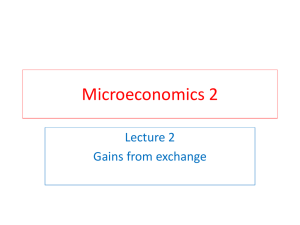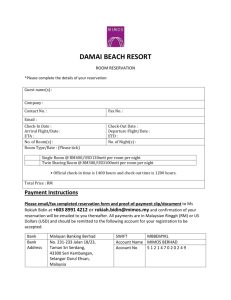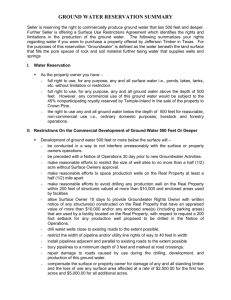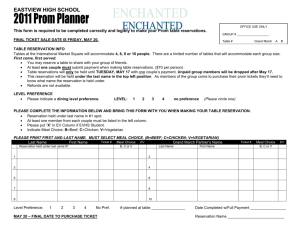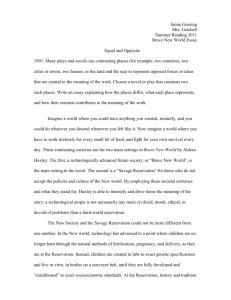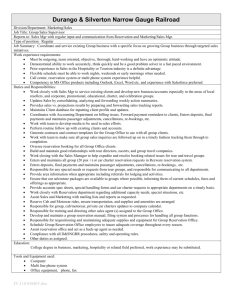results from experiments
advertisement
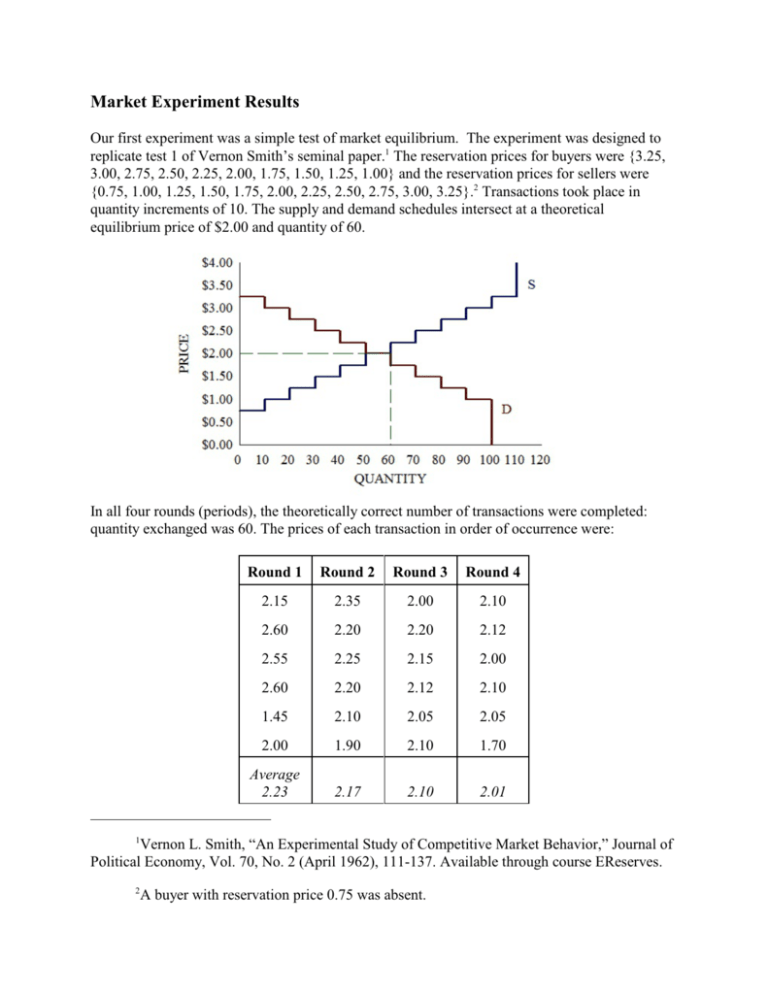
Market Experiment Results
Our first experiment was a simple test of market equilibrium. The experiment was designed to
replicate test 1 of Vernon Smith’s seminal paper.1 The reservation prices for buyers were {3.25,
3.00, 2.75, 2.50, 2.25, 2.00, 1.75, 1.50, 1.25, 1.00} and the reservation prices for sellers were
{0.75, 1.00, 1.25, 1.50, 1.75, 2.00, 2.25, 2.50, 2.75, 3.00, 3.25}.2 Transactions took place in
quantity increments of 10. The supply and demand schedules intersect at a theoretical
equilibrium price of $2.00 and quantity of 60.
In all four rounds (periods), the theoretically correct number of transactions were completed:
quantity exchanged was 60. The prices of each transaction in order of occurrence were:
Round 1
Round 2
Round 3
Round 4
2.15
2.35
2.00
2.10
2.60
2.20
2.20
2.12
2.55
2.25
2.15
2.00
2.60
2.20
2.12
2.10
1.45
2.10
2.05
2.05
2.00
1.90
2.10
1.70
Average
2.23
2.17
2.10
2.01
1
Vernon L. Smith, “An Experimental Study of Competitive Market Behavior,” Journal of
Political Economy, Vol. 70, No. 2 (April 1962), 111-137. Available through course EReserves.
2
A buyer with reservation price 0.75 was absent.
While the prices tended to be too high, the average price of each round converged to almost
exactly the predicted equilibrium price of 2.00.
Buyer’s surplus is reservation price minus contract price times ten for each completed
transaction; seller’s surplus is contract price minus reservation price times ten. Predicted total
surplus (sum of buyer’s surpluses and seller’s surpluses) over all four rounds was 300; the actual
was 287.5, so only 12.5 (or 4.2%) short of full efficiency.
In round one, there was a transaction at $2.55 by a seller with reservation price $2.50 instead of
reservation price $2.00 (efficiency loss $5.00) and also a transaction at $1.45 by a buyer with
reservation price $1.50 instead of reservation price $2.00 (efficiency loss $5.00). In round 4,
there was a transaction at $1.70 by a buyer with reservation price $1.75 instead of $2.00
(efficiency loss $2.50). Of the 24 total transaction, 21 (87.5%) were fully efficient. While not
generating any loss in efficiency, in round 3, the buyer with reservation price $2.00 irrationally
paid $2.10 (to a seller with reservation price $1.00).
Our second experiment was a reduction in supply, to represent the effects on the gas market of
reduced supply due to hurricanes. We want to know whether the experiment will generate price
increases and quantity decreases of the right magnitudes according to theory. The reservation
prices for buyers were {3.25, 3.00, 2.75, 2.50, 2.25, 2.00, 1.75, 1.50, 1.25, 1.00, 0.75} and the
reservation prices for sellers were {1.25, 1.50, 1.75, 2.00, 2.25, 2.50, 2.75, 3.00, 3.50, 3.75}.3
The supply curve shifted up by $0.50 (or more at high end). Transactions again took place in
quantity increments of 10. The supply and demand schedules intersect at a theoretical
equilibrium price of $2.25 and quantity of 50. The price should rise $0.25 and quantity fall 10
relative to the first experiment.
In all the first three rounds, the theoretically correct number of transactions were completed:
quantity exchanged was 50. In the fourth round, only 40 was exchanged, but the missing
transaction was for the buyer with reservation price $2.25 to purchase from the seller with
reservation price $2.25 (at a price of $2.25), which yields no surplus so did not generate any
efficiency loss.4 The prices of each transaction in order of occurrence were:
3
4
Round 1
Round 2
Round 3
Round 4
2.30
2.15
2.24
2.30
2.50
2.00
2.35
2.25
2.30
2.25
2.20
2.20
2.10
2.30
2.20
2.25
2.15
2.20
2.30
Average
2.27
2.18
2.26
2.25
A seller with reservation price 3.25 was absent.
Buyers and sellers should be instructed to be willing to complete transactions at their
reservation price if they can do no better.
The average price in round 2 was a little low, but otherwise the average prices were right on the
mark at or very near 2.25.
Predicted total surplus (sum of buyer’s surpluses and seller’s surpluses) over all four rounds was
200; actual surplus was 200 so fully efficient! Some buyers and sellers did a bit better or worse
than predicted in terms of their own surplus, but it all netted out.
Our third experiment was a price ceiling at $2.00, under the same demand and supply conditions
as the second experiment. The reservation prices for buyers were {3.25, 3.00, 2.75, 2.50, 2.25,
2.00, 1.50, 1.25} and the reservation prices for sellers were {1.25, 1.50, 1.75, 2.00, 2.25, 2.50,
2.75, 3.00, 3.25, 3.50, 3.75}.5 With a price ceiling of $2.00, theory says only a quantity of 40
should be exchanged. Quantity demanded should be 60, while quantity supplied should be 40, so
there should be excess demand of 20.
5
Buyers with reservation prices 0.75, 1.00, and 1.75 were absent.
We want to know whether quantity falls to the correct degree. We also want to see which buyers
are dissatisfied due to excess demand. Does the market succeed in allocating the 40 gallons to
the buyers who value them most? Are the buyers with higher reservation prices more successful
in completing a transaction than those with lower valuations?
In all eight rounds, the theoretically correct number of transactions were completed: quantity
exchanged was 40. The prices of each transaction in order of occurrence were:
Round 1
Round 2
Rounds 3-8
2.00
1.95
2.00
2.00
2.00
2.00
1.95
2.00
2.00
1.90
2.00
2.00
Average
1.96
1.99
2.00
All but three of the 32 transactions occurred at the price ceiling of $2.00. The three lower prices
of $1.95, $1.90 and $1.95 took place early: they were the third, fourth and fifth transactions
overall. The outcome quickly converged on the predicted price.
Predicted total surplus (sum of buyer’s surpluses and seller’s surpluses) over all eight rounds was
400; actual surplus was 333, so there was a 17% loss in efficiency due to buyers with higher
valuations going dissatisfied.
There is only weak evidence that buyers with higher reservation prices were somewhat more
successful in completing transactions. Ordinarily, price would increase in response to excess
demand – a price ceiling thwarts the normal adjustment process that assures units are allocated to
buyers with the highest valuations.
Reservation price
Transactions Completed
Success Rate
3.25
7/8
88%
3.00
6/8
75%
2.75
5/8
63%
2.50
2/8
25%
2.25
7/8
88%
2.00
5/8
63%
